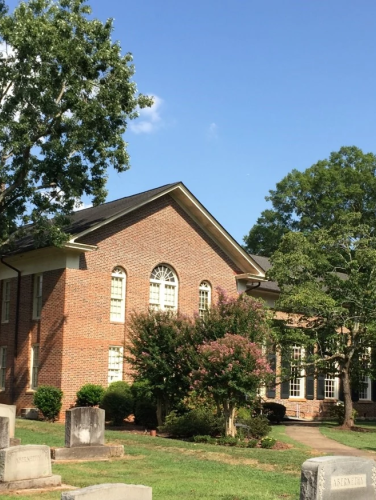
Hopewell Presbyterian Church
(ca. 1833)
Hopewell Presbyterian Church is the home of one of Mecklenburg County’s earliest Presbyterian congregations.
10500 Beatties Ford Road, Huntersville, NC 28078
Housing one of the first Presbyterian congregations in Mecklenburg County, the Hopewell Presbyterian Church building is also one of the county’s oldest and finest Federal Style churches. Religious services conducted by itinerate ministers from the Presbyterian Synods of Philadelphia and New York began among the Hopewell area’s Scotch-Irish settlers as early as the 1750s. The congregation formally organized and erected a log structure for its first meeting house in 1762, making it one of only seven pre-Revolutionary War churches in the area (all Presbyterian). Hopewell’s original congregants included such leaders of the local gentry as John McKnitt Alexander, Major John Davidson, James Latta, Hugh Torance, and Alexander Caldwell.
Property Quick Links
By the antebellum period, Hopewell was the wealthiest of the county’s seven original Presbyterian congregations, primarily because its membership included several prominent planters who operated sizable local plantations. As those agricultural operations relied heavily on the involuntary labor of enslaved African Americans, slavery accounted for much of Hopewell’s wealth. The first four pastors of Hopewell – Rev. Samuel Craighead Caldwell, Rev. John Williamson, Rev. Hugh B. Cunningham, and Rev. Samuel Caldwell Pharr – also owned several enslaved people, many of whom were among the 165 enslaved people who were members of the Hopewell congregation between 1843 and 1864.
During the Revolutionary War, the log structure gave way to a frame building (c. 1777) that served as the congregation’s meeting house until the 1830s when construction began on the current brick building. It was built at an estimated cost of $3,000. Upon its completion, the Hopewell church was only the second bricked Presbyterian Church in rural North Carolina. A significant remodel in the late 1850s converted the 1833 brick structure into its current Federal Style architecture. A narthex and gallery were added. The gallery provided a segregated entrance and seating for the church’s enslaved members. The main brick floor was removed. The windows doubled in height, literally raising the roof. The congregation also added a pulpit. Enslaved labor likely contributed to much of that construction. Despite that work and subsequent modifications since the 1860s, much of the original 1833 structure remains.
The distinctive stone walls and piers located on the church grounds between its main building and Beatties Ford Road were designed and constructed in the 1920s at the behest of E. L. Baxter Davidson, the great-grandson of Revolutionary War veteran Major John Davidson, the original owner of the Rural Hill estate in Huntersville. A successful local businessman, Baxter Davidson financed and oversaw the construction of similar stone structures at Williams Memorial Presbyterian Church in Charlotte and various stone monuments across north Mecklenburg County commemorating General William Lee Davidson and the battles of Cowan’s Ford and McIntyre’s Farm. The Hopewell church property also includes four cemeteries, the oldest having been used between 1775 and 1840. Many of Mecklenburg County’s earliest notable citizens are interred in those cemeteries.

